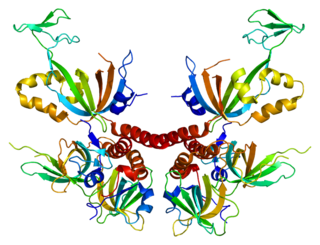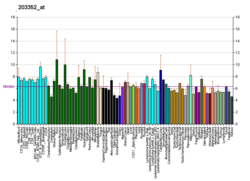
DNA replication licensing factor MCM6 is a protein that in humans is encoded by the MCM6 gene. MCM6 is one of the highly conserved mini-chromosome maintenance proteins (MCM) that are essential for the initiation of eukaryotic genome replication.

Eukaryotic DNA replication is a conserved mechanism that restricts DNA replication to once per cell cycle. Eukaryotic DNA replication of chromosomal DNA is central for the duplication of a cell and is necessary for the maintenance of the eukaryotic genome.

Serine/threonine-protein phosphatase 2A catalytic subunit alpha isoform is an enzyme that is encoded by the PPP2CA gene.

DNA replication licensing factor MCM7 is a protein that in humans is encoded by the MCM7 gene.

DNA replication licensing factor MCM2 is a protein that in humans is encoded by the MCM2 gene.

DNA replication licensing factor MCM3 is a protein that in humans is encoded by the MCM3 gene.

Cell division control protein 6 homolog is a protein that in humans is encoded by the CDC6 gene.

DNA replication licensing factor MCM4 is a protein that in humans is encoded by the MCM4 gene.

Origin recognition complex subunit 2 is a protein that is encoded by the ORC2 (ORC2L) gene in humans.

Replication factor C subunit 4 is a protein that in humans is encoded by the RFC4 gene.

Replication factor C subunit 2 is a protein that in humans is encoded by the RFC2 gene.

Cell division cycle 7-related protein kinase is an enzyme that in humans is encoded by the CDC7 gene. The Cdc7 kinase is involved in regulation of the cell cycle at the point of chromosomal DNA replication. The gene CDC7 appears to be conserved throughout eukaryotic evolution; this means that most eukaryotic cells have the Cdc7 kinase protein.

Replication factor C subunit 5 is a protein that in humans is encoded by the RFC5 gene.

Protein DBF4 homolog A is a protein that is encoded by the DBF4 gene in humans.

Origin recognition complex subunit 6 is a protein that in humans is encoded by the ORC6 (ORC6L) gene.

Origin recognition complex subunit 5 is a protein that in humans is encoded by the ORC5 (ORC5L) gene.

Origin recognition complex subunit 3 is a protein that in humans is encoded by the ORC3 (ORC3L) gene.

Mediator of RNA polymerase II transcription subunit 30 is an enzyme that in humans is encoded by the MED30 gene. It represents subunit Med30 of the Mediator complex and is metazoan-specific, having no homologues in yeasts.

Origin recognition complex subunit 1 is a protein that in humans is encoded by the ORC1 gene. It is closely related to CDC6, and both are the same protein in archaea.

Replication protein A 14 kDa subunit is a protein that in humans is encoded by the RPA3 gene.


















